

 |

|
|
|
|
Casting Belt Buckles
|
 |
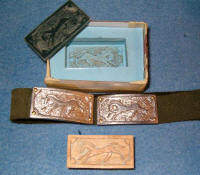 |
| The master could be made from a bought key chain. The small items can also be used to stamp leather. | Note the detailed picked up in the mold. |
Making a container to hold the mold that is just larger than the mold needs to be (or find the perfect little box or container).
I used a two part Silicon rubber mode for these examples.
Mix your compound and pour it in the container and drop your master in the material. The wood masters will float on the silicone - however if your master is a metal one - you need to figure a way to suspend it or it will sink.
It is possible with these materials to make 2-part molds. All my belt buckle molds are one part molds.
 |
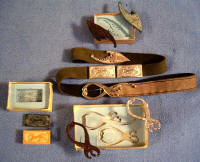 |
| Start with two part epoxy or tin... cast the master .... | ... and get.... these! |
The metal alloy is a tin-bismuth lead alloy that has a low enough melting temperature that you can use a propane torch to melt it. There are several casting metals available. The one that is just tin-bismuth is rather brittle. The alloys with lead in them are much less brittle but require higher temperatures- but, still in the propane torch range. These alloys are soft enough that you can carve in it and sand it smooth.
The higher temperatures affect the molds. Mold life is longer with lower temperature casting.
Remember LEAD IS A TOXIC MATERIAL- always use caution when handling this stuff!!! Melt it in an exhaust hood or outside!
If you use plastics like epoxy, it is a 2-part mixture and is able to take a pigment so you can color it. The plastic is just like model plastic - able to be carved and sanded and painted.
Molds should last a long time using plastic resin. All this is available from www.micromark.com .
To eliminate bubble problems in the bottom of your molds - sprinkle a very fine layer of talcum powder into the bottom of the mold. Poor gently.
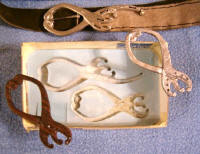 |
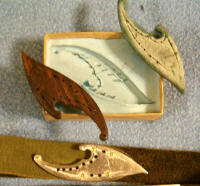 |
| Bottom left - wood master, far right -cast buckle with holes drilled, top center - painted, tongue added and attached to the belt. | Master in this one has the holes drilled and the stitch part carved. |
Once the pieces are removed from the mold they will need sanding and finishing.
From these molds I can cast the 2-piece hinged buckle. I have cast some in plastic - which is surprisingly tough - and from a metal alloy . I use a four-penny nail in the hinge and to hold the bail . They actually work and hold up quite well as I have had no failures
Some of these pieces I actually attached with thread - just like sewing them on. If you are not too rough on your belt this would be fine.
Later I began to use small brass nails to attach them. Drill some holes in the buckle and pass the nail through and bend it over in the back.
The ideal attachment would be a rivet back. I am still working on this. The rivets would have to be suspended while the metal is poured. Harder than it sounds and nearly impossible on the smaller buckles.
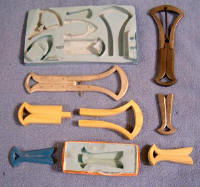 |
 |
| Pieces of Strider's hinged belt buckle | See the finals painted. (This photo has been lightened. See the top of the article for the unlightened version.) |
See more of Ason's work in the Scrapbook...
See more about Casting...
This page was last updated 04/22/08